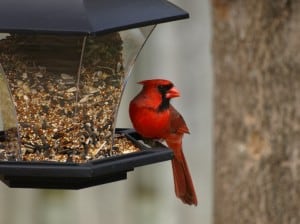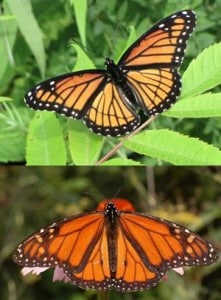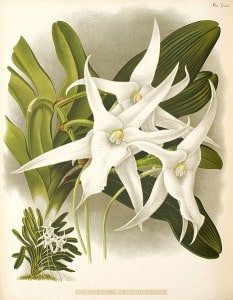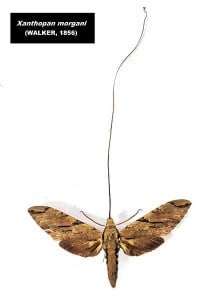A basic understanding of the theory of evolution provides both emotional and intellectual satisfaction to the experience of observing nature. It adds a whole new level of appreciation to the cardinal you’re watching at your feeder or to the orchid that’s blooming on your windowsill. Evolution allows us to ask “why questions” such as “why are male cardinals so brightly coloured?” and to expect a reasonable answer. And, as we all know, the answer to a why question is deeply satisfying.
At its simplest, the theory of evolution – theory meaning a unifying principle that explains a body of facts – describes how modern organisms have “descended with modifications” from ancient ancestors as a result of genetic inheritance. It’s central idea is that all life on Earth shares a common ancestor, just as you and your cousins share a common grandfather and grandmother. It therefore means that we’re all distant cousins: humans and cardinals, Monarch butterflies and orchids.
In a nutshell, evolution can be understood like this: All creatures struggle to survive and reproduce but many fail. Any creatures born with a new, helpful trait are the most likely to live long enough to reproduce. Parents pass on the useful trait to their young. Over time, the population with the new trait(s) becomes so different that it has “evolved” into a new species – in other words, a group of organisms that can only reproduce with individuals of this same, new group. For example, cardinals can only breed with cardinals and robins with robins.
Now, let’s take a slightly more detailed look. Charles Darwin, a 19th century English naturalist and the father of the theory of evolution, realized that plants and animals have far more offspring than they need in order to replace themselves. He reasoned that if all the offspring were to survive, the planet would quickly be over-run. He therefore wondered why some of the young endure – at least long enough to reproduce – while others don’t. He did, of course, recognize that life is a struggle and finding food, a mate, shelter and other essentials is rarely easy. Darwin had the genius, however, to notice that not all offspring are exactly the same. In every generation, there are slight differences in size, colour, behaviour and other features. He therefore concluded that some of these traits (e.g., a larger, stronger beak) would give the individual an advantage over its siblings and therefore improve its chances of surviving and reproducing. He called this “natural selection”. Nature is, in a sense, choosing or “selecting” those individuals that will survive.
Imagine a species of beetles. Because there is variation in traits, you could have some individuals that are green and others that are brown. We see this phenomenon in Gray Squirrels, in which some are black and others grey. Imagine a new predator arrives on the scene and is able to more easily spot and eat the green beetles. This means that fewer green beetles will survive to reproduce than brown beetles. The surviving brown beetles will have brown babies because colour in this example is a genetic trait. The advantageous trait of being brown will become more common in the population and eventually all of the beetles will be brown.
You have a great example of natural selection observable right in your own garden with the Viceroy butterfly. Through natural selection, Viceroys – a non-poisonous species – have evolved to almost perfectly mimic the poisonous Monarch butterfly in appearance. Because birds learn that certain wing patterns and colours are unpalatable, they not only avoid attacking Monarchs but also avoid the near-identical Viceroys. This, of course, provides Viceroys with protection and has helped countless generations to survive and pass on their genes.
Natural selection of a different kind can be seen in the appearance and behaviour of the male birds at your feeder. In this case, the selection pressure is coming from the female. Known as sexual selection, it determines which males will get to mate. Remember, males compete for access to females and not all males win the jackpot. So, who are the lucky guys? Well, depending on the species, the fastidious female may decide that she especially likes males with brightest feathers or the most vigorous song. In her estimation, these traits make the suitor genetically superior and more “fit” to be a father. Males with these traits will therefore get to mate more often and the traits will be passed down to the offspring. It is sexual selection – the end result of the decisions of countless generations of females – that explains why male cardinals are so ridiculously red and why they pour their souls out in lusty song. Bright coloration and loud song from exposed perches have a downside, however, in that it means male cardinals are more easily detected by predators. Nature is always a series of trade-offs.
This leads to two important thing to keep in mind about natural selection. This process does not produce perfection. No population or organism is ever perfectly adapted. A predator is never fast enough to catch its prey every time it is hungry, nor is it perfectly protected from enemies. Natural selection is not random, either. Randomness only apples to gene mutations. As a result of natural selection, mutations that aid survival and reproduction are much more likely to be “selected” than mutations that don’t. This is the opposite of random.
Although it was not understood in Darwin’s time, new traits occur because of changes in DNA, a long, chain-like molecule inside every cell of every living creature. A section of DNA forms a gene. Plants and animals can have hundreds or thousands of genes. There are genes for everything from eye colour to whether hair is straight or curly. Together, the genes act like a “recipe” for growing a living thing. However, when a cell divides and makes a copy of its DNA, the copy is not always perfect. The small difference between the original and the copy is called a mutation. The mutation can slightly change the recipe. Mutations can have a big effect, small effect or no effect.
Not all selection is natural. The term “artificial selection” is used when humans – usually farmers and breeders – do the selecting and allow only the plants and animals with the most desirable characteristics to reproduce. This has led to the evolution of everything from different breeds of dogs to different vegetables. Just by starting with wild mustard, breeders have been able to cultivate broccoli, cabbage, cauliflower, kale and kohirabi. They are all the same plant species. As for dogs, they are all direct descendents of the Gray Wolf, Canis lupus and therefore all domesticated wolves. The 150-plus dog breeds we see today are the result of purposeful interbreeding of dogs over the last couple of centuries.
New species resulting from evolution are usually just updates, not radical redesigns. For example, the same basic body plan (e.g., four legs) usually remains. A good example is the similarity in the skeletons of humans, horses and dogs. Some species are so well adapted to their habitat and lifestyle, that they have hardly changed since the time of the dinosaurs (e.g., crocodiles, dragonflies).
The term co-evolution is used to describe cases where two (or more) species affect each other’s evolution. For example, an evolutionary change in the features of a flower might affect the features of a pollinator that visits that flower, which in turn might affect the evolution of the flower… and so on. For example, you would not have the amazing shapes, markings and colours of your orchid house plants if it weren’t for the insects that pollinate them. Compelling evidence for co-evolution can be seen in Darwin’s Orchid, Angraecum sesquipedale. This orchid has an extremely long , hollow spike – so long that only an insect with a 12 inch proboscis (tubular mouthpart) can reach the nectar inside. Darwin actually predicted that there had to be a species of moth out there with such a proboscis in order for the orchid to be pollinated. Well, he was right. In 1903, twenty years after Darwin’s death, Morgan’s sphinx moth was discovered. The moth has a foot-long proboscis that can reach down into the flower to retrieve the precious nectar. In the process, the moth rubs its head against the pollen-producing organ of the plant and transfers the pollen to the next flower it drinks nectar from .
To learn more about evolution, I would recommend visiting “Understanding Evolution” at http://evolution.berkeley.edu/ and watching the PBS series on evolution at http://www.pbs.org/wgbh/evolution/. It is also available on YouTube.



